Physical Address
304 North Cardinal St.
Dorchester Center, MA 02124
Echocardiography plays a key role in the management of patients undergoing cardiac procedures in the operating room, cardiac catheterization laboratory, and hybrid procedure suites. Echocardiographic approaches include transthoracic echocardiography (TTE), transesophageal echocardiography (TEE), epicardial imaging, or intracardiac echocardiography, depending on the specific procedure and monitoring needs. TTE imaging typically is performed by a cardiac sonographer or noninvasive cardiologist, epicardial imaging by the cardiac surgeon, and intracardiac echocardiography is performed by the interventional cardiologist. Intraoperative or intraprocedural TEE typically is performed by appropriately trained cardiovascular anesthesiologists or cardiologists.
The principles of diagnostic TEE and intraoperative TEE are identical in terms of image plane orientation, anatomic findings, and Doppler flow patterns (see Chapter 3 ). In addition, standard methods for the evaluation of ventricular systolic and diastolic function, valve dysfunction, congenital heart disease, and so on, as described in previous chapters, are also used for intraoperative TEE. Three-dimensional (3D) echocardiography is particularly important during monitoring of procedures in the operating room and is essential for guidance during some transcatheter procedures.
Typically, baseline TEE data are recorded after the induction of anesthesia but before cardiopulmonary bypass or beginning the interventional procedure. TEE data are again recorded after the surgical or transcatheter intervention and weaning from cardiopulmonary bypass. As with diagnostic TEE, intraprocedural TEE provides images of great clarity and diagnostic value. However, intraprocedural TEE differs from standard diagnostic TEE in several respects:
Time constraints often require a focused examination.
Altered loading conditions affect the evaluation of valve and ventricular dysfunction.
Baseline and postintervention evaluations should have matched loading conditions.
Urgent decision making based on imaging information may be necessary.
Any limitations of the TEE information must be promptly recognized.
Clear communication between the echocardiographer and surgeon or interventional cardiologist is essential.
This chapter provides an introduction to the basic principles and major clinical applications of intraoperative TEE. Echocardiographers who practice intraprocedural TEE should review training guidelines and refer to the additional books and articles included in the Suggested Reading at the end of this chapter ( Table 18.1 ). In addition, other imaging modalities often are used in the operating room (e.g., epicardial echocardiography) and in the interventional laboratory (e.g., fluoroscopy or intracardiac echocardiography) for procedural guidance (see Chapter 4 ).
| Qualifications | Basic | Advanced | Maintenance of Competence |
|---|---|---|---|
| TEE studies interpreted and reported (supervised) | 150 | 300 | 50 exams/year (25 personally performed) |
| TEE studies performed (supervised) | 50 | 150 | 15 Category I CME hours every 3 years |
| Program director | Advanced perioperative training | Advanced training plus 150 additional exams | Participation in a CQI program |
| Program (perioperative exam volume and diversity) | Wide variety | Full spectrum | |
| Documentation of training | NBE certification or verification by training director | ||
* This table shows the minimum number of procedures recommended to achieve and maintain competency.
The indications for intraprocedural TEE range from basic monitoring of cardiovascular function to evaluation of function after complex intracardiac surgical repairs ( Table 18.2 ). In addition to traditional surgical approaches in the operating room with full cardiopulmonary bypass, TEE now also is used with alternate surgical and transcatheter approaches. The role of TEE has become more important as imaging replaces direct visualization of cardiac structure and function.
| Clinical Setting | Procedure | Timing and Goals |
|---|---|---|
| Monitoring ventricular function | Before and after cardiopulmonary bypass in high-risk patients | LV volumes, global and regional function |
| During noncardiac surgery in high-risk patients | LV volumes, global and regional function | |
| Cardiac surgical procedures | Mitral valve repair | Mechanism and severity of MR Residual MR and complications after mitral valve repair |
| Prosthetic valve replacement | Evaluation after valve implantation | |
| Detection of complications | ||
| Complex surgical valve procedures | Aortic valve resuspension and aortic root repair | |
| Coronary artery reimplantation | ||
| Endocarditis | Valve involvement and dysfunction | |
| Assessment after repair or valve replacement | ||
| Hypertrophic cardiomyopathy | LV outflow anatomy before and after myectomy Evidence of subaortic obstruction |
|
| Aortic dissection repair | Dissection flap location and flow Residual dissection after repair |
|
| Congenital heart disease | Complex anatomy and function before and after surgical repair | |
| Transcatheter interventions | Transcatheter aortic valve implantation (TAVI) | Aortic valve anatomy and function before and after valve implantation |
| Transcatheter mitral valve procedures (balloon valvotomy, mitral clip placement, transcatheter mitral valve implantation) | Mitral valve function before and after procedure Guidance during procedure |
|
| Prosthetic valve dysfunction | Guide and monitor transcatheter closure of paravalvular regurgitation Guide valve-in-valve implantation |
|
| Atrial septal defect or patent foramen ovale closure | Baseline size and anatomy of defect Residual shunt post-procedure Assess for complications |
|
| Septal ablation for hypertrophic cardiomyopathy | Baseline and post-procedure LV outflow obstruction Determine optimal site for ablation |
|
| Placement of intracardiac devices | Cannula placement | Guide positioning during placement |
| Ventricular assist devices | ||
| Aortic cannulation (avoid atheroma) | ||
| General surgical complications | Loculated pericardial effusion after surgical or transcatheter procedures | Detection, size, and hemodynamic consequences |
| Intracardiac air after surgical procedures | Recognition and treatment |
For elective surgical and transcatheter procedures, the diagnosis and surgical plan should be determined before the operative date ( Fig. 18.1 ). Often, diagnostic TEE is performed as part of surgical planning in addition to other diagnostic imaging studies, such as coronary angiography, cardiac magnetic resonance (CMR) imaging, or computed tomography (CT). This allows time to review and discuss the diagnostic data, resolve any apparent discrepancies, and obtain additional data, as needed. In addition, the surgical options can be reviewed and discussed with the patient.
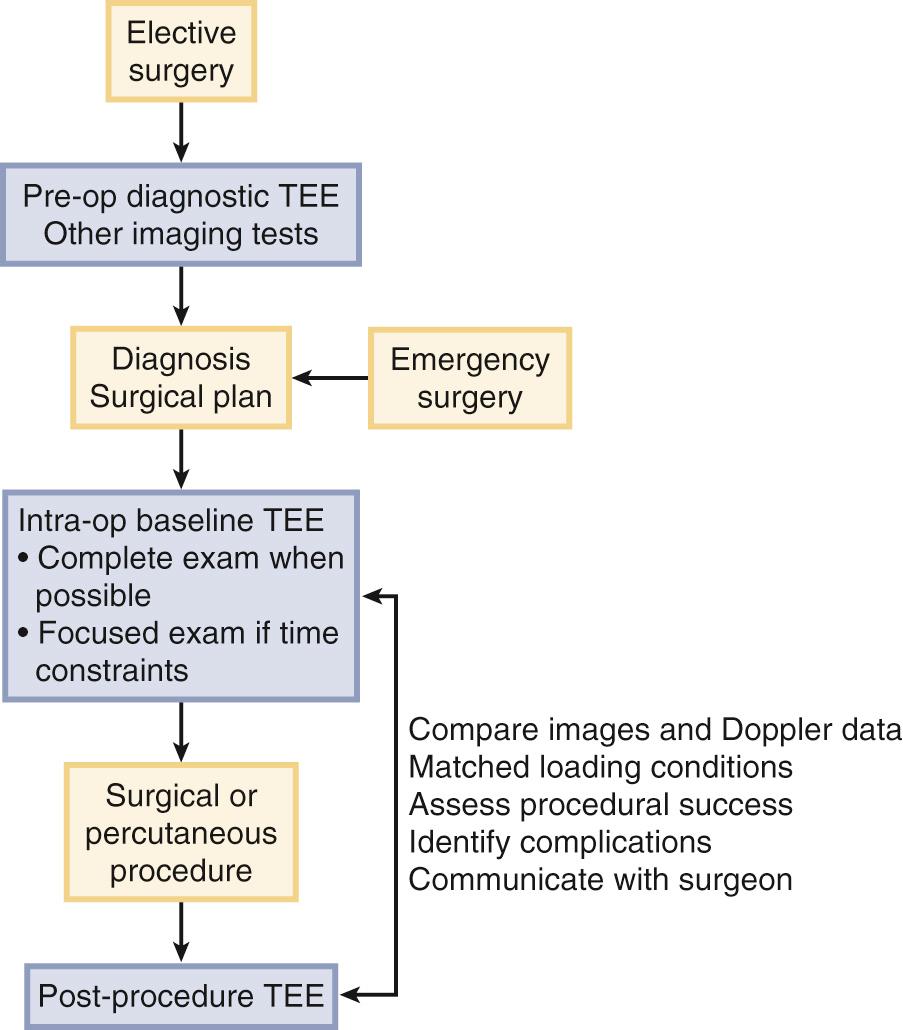
Preoperative assessment is particularly important for valvular and congenital heart disease, both for technical and physiologic reasons. From a technical point of view, valve stenosis is best evaluated by TTE imaging, which allows multiple interrogation angles to ensure that the maximum jet velocity is recorded. On TEE, the constraints in transducer position often result in underestimation of stenosis severity. From a physiologic point of view, the altered loading conditions during anesthesia frequently result in underestimation of regurgitant severity, for example, if afterload is reduced.
Even when the preoperative diagnostic evaluation is complete, baseline intraprocedural TEE is important to:
Confirm the diagnosis
Provide additional information on valve repairability
Serve as a baseline comparison for the postprocedure study
Check for other abnormalities
Monitor left ventricular (LV) function
In elective cases, when unexpected findings are present on the baseline intraprocedural TEE, management is individualized based on the specific findings and the urgency of the procedure. Usually, the surgical procedure can be modified as needed; for example, closure of an incidental patent foramen ovale at the time of mitral valve repair. However, major unexpected findings may require consultation with the patient's primary cardiologist or rescheduling of the procedure.
In emergency cases, the intraprocedural TEE recorded before cardiopulmonary bypass sometimes is the primary diagnostic study. For example, with an acute aortic dissection, promptly transferring the patient to the operating room and obtaining TEE images quickly after the induction of anesthesia may be optimal. In these situations, the echocardiographer should ensure that the diagnosis is correct, evaluate for complications, and promptly communicate this information to the surgeon.
Assessment of cardiac hemodynamics and ventricular function in the operating room is affected by:
Positive pressure mechanical ventilation
Volume status
Myocardial “stunning” secondary to aortic cross-clamping
Effects of cardiopulmonary bypass
Pharmacologic therapy
Typically, general anesthesia is provided by inhalational agents with supplemental opioids and muscle relaxants, all of which alter preload and afterload. Many agents impair myocardial contractility, decrease systemic vascular resistance, or both. During weaning from cardiopulmonary bypass, vasodilators or vasopressors may be used to maintain a normal systemic vascular resistance, and inotropic agents may be used if ventricular systolic function is impaired. Positive pressure ventilation at baseline and after cardiopulmonary bypass reduces systemic venous return because of the increase in intrathoracic pressure; this effect is most pronounced when ventricular filling volumes are low. The combination of changes in preload, afterload, and contractility result in variation in the severity of valve regurgitation ( Fig. 18.2 ). Antegrade velocities and pressures gradients also vary with volume flow rates.
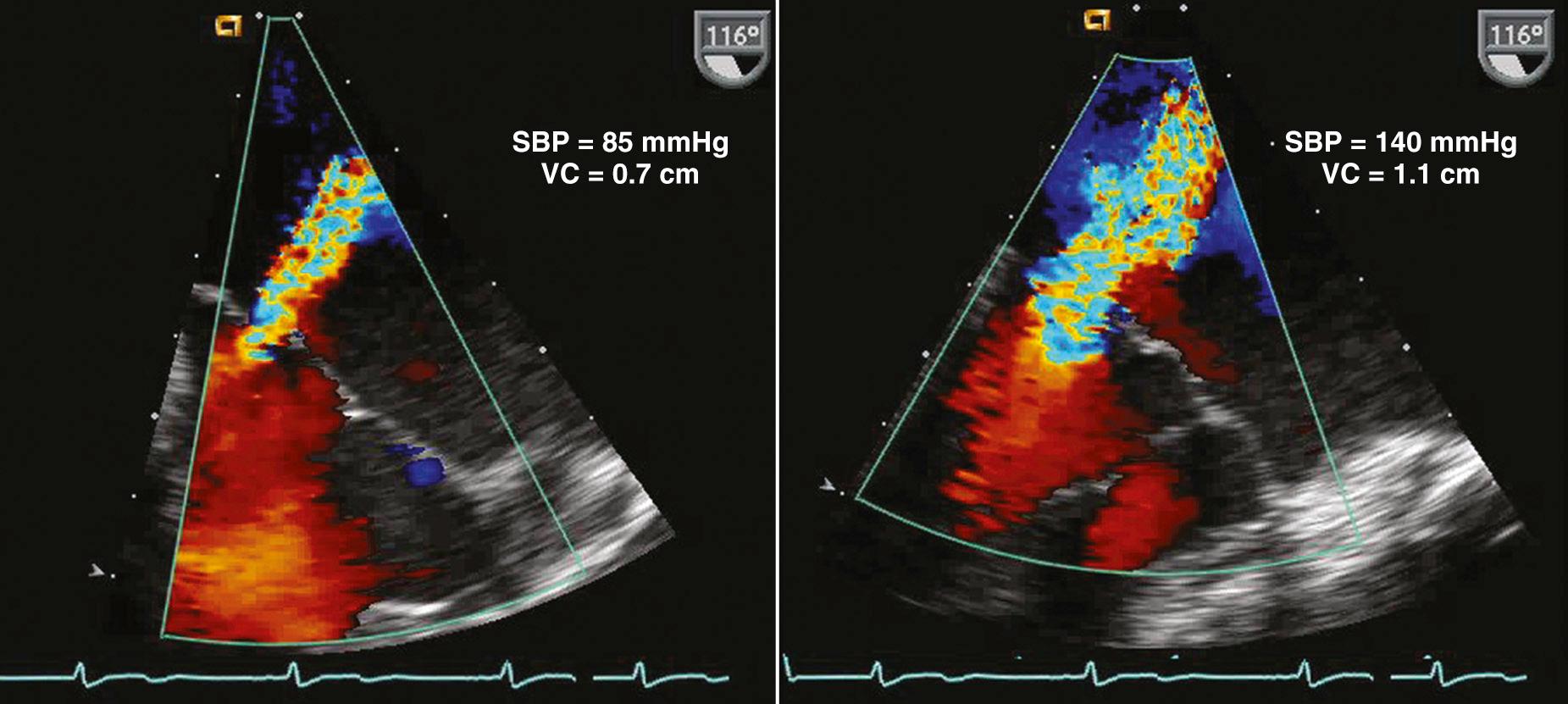
TEE images and Doppler data optimally are recorded at loading conditions similar to those in the patient's baseline state and with matched loading conditions on the baseline and post–cardiopulmonary bypass studies. Basic parameters, such as heart rate and blood pressure, should be recorded on the echocardiographic images to ensure comparable loading conditions, with measures of systemic vascular resistance, filling pressures, and cardiac output also noted, when possible. After the patient is weaned from cardiopulmonary bypass, preload on the postbypass study is optimized with volume infusion, often by using TEE images of LV size as a measure of LV filling status, and afterload is adjusted using pharmacologic agents as needed, to match the baseline study.
During an open cardiac surgical procedure, the effects of surgical manipulation are directly observable on the TEE images ( Fig. 18.3 ). For example, if the left atrial (LA) appendage was inverted during a mitral valve repair procedure, the inverted appendage sometimes appears as a “mass” in the LA that disappears when the appendage resumes its normal shape. Cannulas for cardiopulmonary bypass are visualized to confirm correct positioning but also result in shadowing and reverberations that limit the evaluation of cardiac function. Infusion of cardioplegia results in a contrast effect with increased echogenicity of the perfused myocardium. Intracardiac air related to the open surgical procedure has a characteristic bright appearance, so that TEE imaging helps ensure that no residual intracardiac air is present at the end of the procedure ( Fig. 18.4 ). Electronic interference from electrocautery creates an artifact on TEE images and disrupts the color Doppler signal.
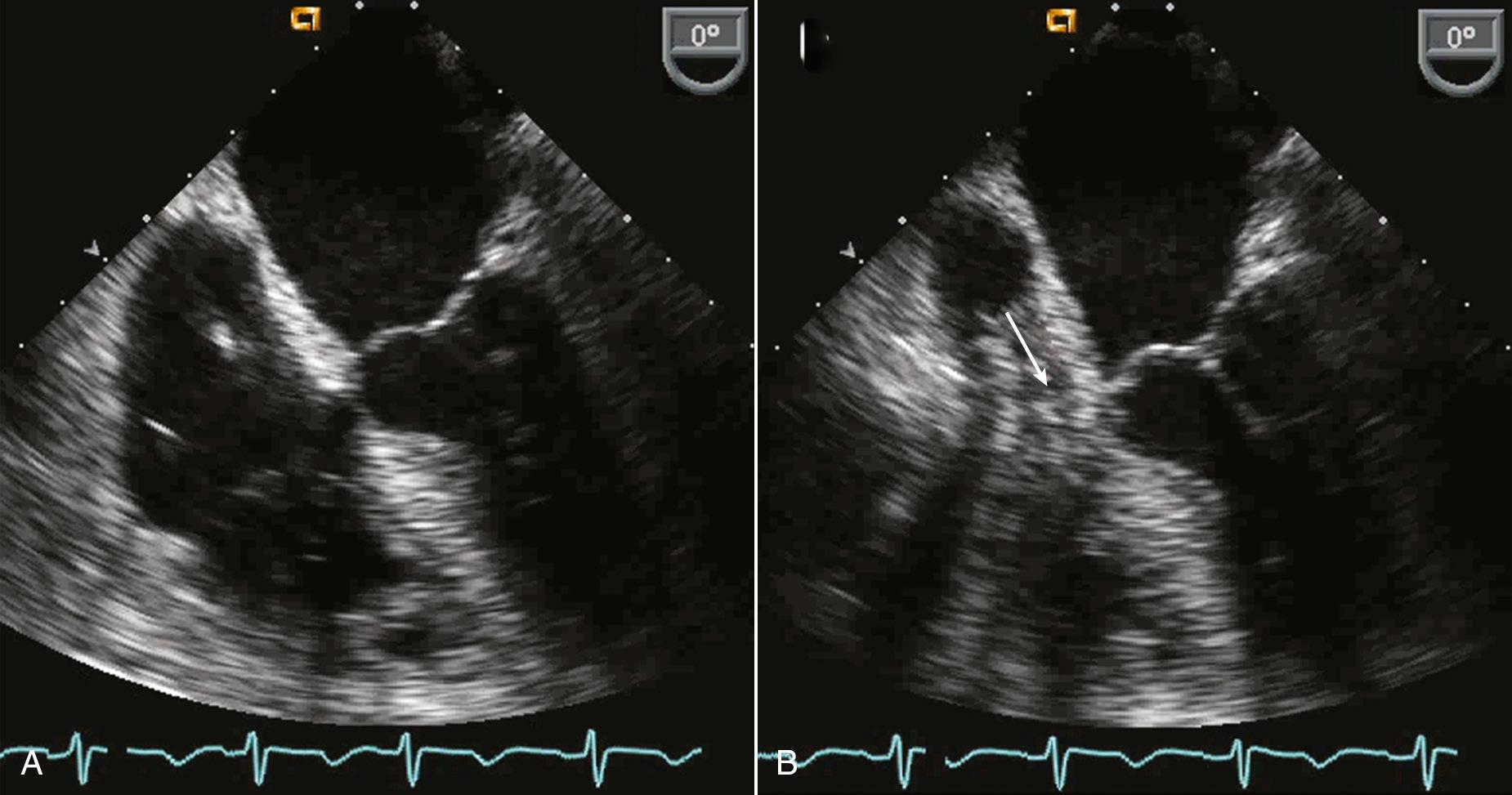

A complete systematic TEE examination is recommended during intraprocedural evaluation whenever possible. However, when clinical urgency limits the time available for imaging, the data needed are prioritized, and the most important images and Doppler data are recorded first, with care taken to ensure that adequate data are recorded for any clinical decision making. Most patients have had a complete diagnostic study before entering the operating room so that the baseline intraprocedural TEE focuses on the views needed for comparison to the postprocedure images.
Quantitative approaches that are simple and fast are preferred over more complex methods, when possible. For example, valve regurgitation quantitation by measurement of vena contracta width is similar and faster than optimizing the proximal isovelocity signal or comparing volume flow rates across the regurgitant valve and a normal valve. LV ejection fraction most often is visually estimated, rather than tracing end-diastolic and end-systolic borders for a biplane ejection fraction calculation. 3D image acquisition with semiautomated border detection facilitates quantitative evaluation of LV function. The use of simultaneous imaging in two planes ( Fig. 18.5 ) and the use of simultaneous two-dimensional (2D) imaging and color Doppler helps minimize the exam time while enabling the echocardiographer to acquire a complete image set. Once images are obtained, the echocardiographer also needs to be cognizant of any limitations in the data and communicate those issues to the surgeon. If the echocardiographic data are essential for decision making, adequate time for imaging without electronic artifacts needs to be provided.
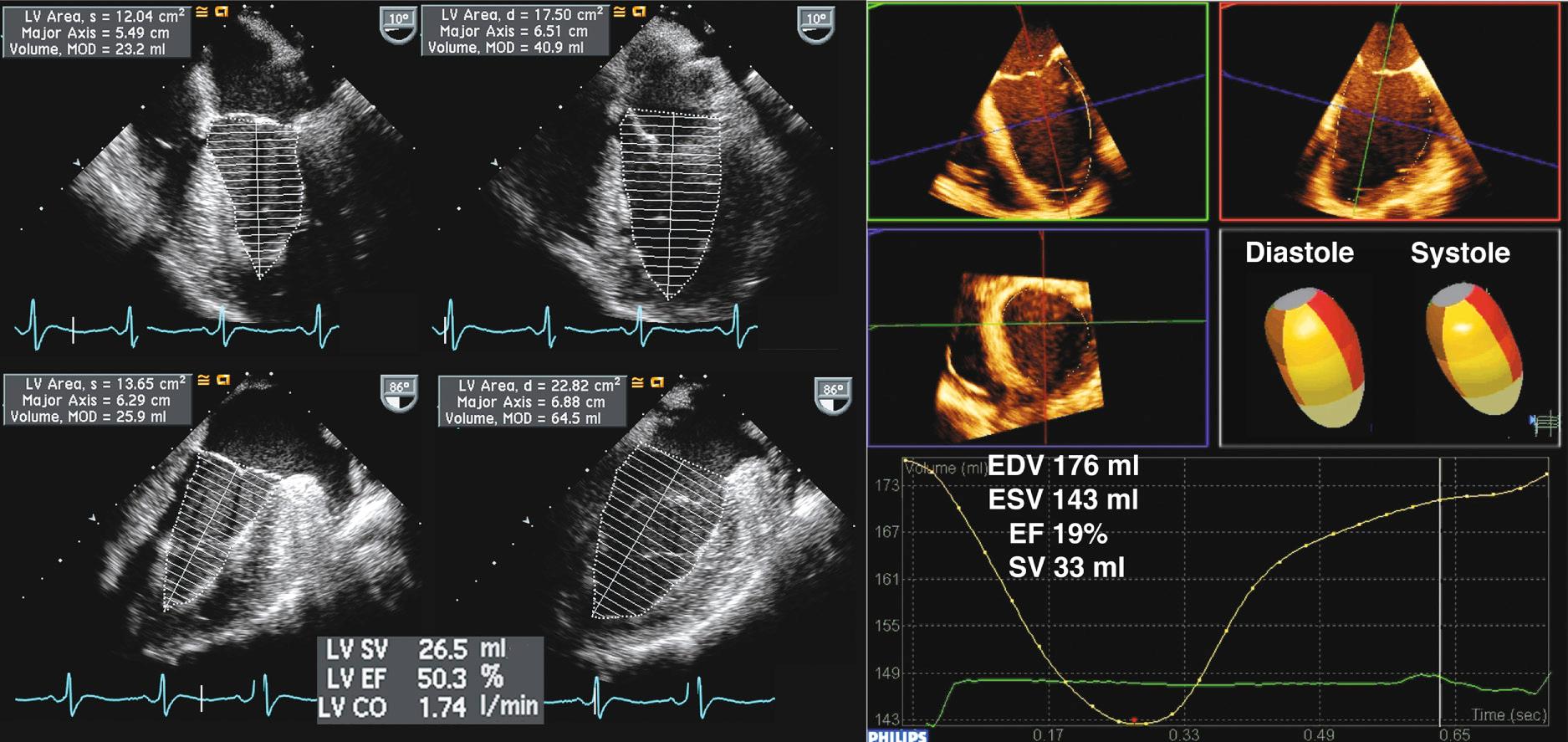
The primary goal of an intraprocedural TEE exam is to address the specific clinical issue in that patient, so a focused examination is appropriate in many situations. However, a complete examination requires only a few minutes and is recommended whenever possible ( Table 18.3 ). The American Society of Echocardiography and the Society of Cardiovascular Anesthesiologists recommend a standard series of 20 2D views that are supplemented by 3D imaging ( Fig. 18.6 ) and Doppler data . Each view is recorded as a 2-second cine loop, so all these images can be recorded within 10 minutes by an experienced operator, even assuming an average of 30 seconds to obtain each view. Additional time is needed for the evaluation of abnormal findings, color and Doppler spectral recordings, and discussions among the anesthesiologist, surgeon, and cardiologist.
| View | Comments |
|---|---|
| Mid-esophageal Views | |
| Evaluate primary study indication | Endocarditis evaluation, cardiac source of embolus, acute aortic syndrome, etc. |
| LV size and function | Depth to include entire LV. Transducer angle 0°–130°. Global and regional function, 3D LV volumes, and EF |
| RV size and function | Depth to include entire RV. Transducer angle 0°–70° |
| Left atrium | Decrease depth to below MV. Sweep across the atrium at transducer angles between 0° and 90°. |
| LA appendage | Biplane imaging. Adjust position to decrease artifact from ridge between LUPV and LAA. Pulsed-wave Doppler of velocities for atrial fibrillation |
| Right atrium | Decrease depth to just below mitral valve. Sweep across the atrium at transducer angles between 0° and 90°. |
| Mitral valve | 2D imaging and color Doppler from multiple views, transducer angle 0°–130°. Quantitation of regurgitation severity, vena contracta, and PISA EROA calculation for more than mild regurgitation. Mitral inflow gradient for stenosis. 3D en face view of valve rotated to aortic valve at top of display |
| Aortic valve | 2D imaging and color Doppler from multiple views, transducer angle 0°–130°. Vena contracta for more than mild regurgitation. 3D en face view of valve rotated to right coronary cusp at bottom of display |
| Ascending aorta (upper esophageal) | Transducer angle 100°. Measure if dilated (sinuses, sinotubular junction, mid-ascending aorta). |
| Tricuspid valve | 2D imaging and color Doppler from multiple views, transducer angle 0°–60° |
| Pulmonic valve | 2D imaging and color Doppler, transducer angle 70° |
| Interatrial septum and bicaval view | 2D imaging and color Doppler at lower Nyquist setting, transducer angle 100°. If shunt suspected, 3D en face view and agitated saline contrast study. If present, evaluate. |
| Pulmonary veins | 2D imaging and color Doppler, transducer angle 0° and 100° for left and right pulmonary veins. Pulsed-wave Doppler if significant MR, to evaluate for flow reversal |
| Pericardial space | Sweep across the heart at a transducer angle of 0°. |
| Transgastric Views | |
| Ventricular function | Evaluate biventricular size and function, transducer angle 0° and 120°. Rotate probe tip rightward for RV and tricuspid valve. En face view of MV with color Doppler if significant MR |
| Deep transgastric view | Advance probe from transgastric view. Visualize LV outflow for Doppler interrogation if needed. |
| Aorta View | |
| Descending thoracic aorta | Image from the diaphragm to the aortic arch. Biplane imaging, 0° and 90°. Pulsed-wave Doppler if significant AR, to evaluate for flow reversal. Image atherosclerotic plaque. |
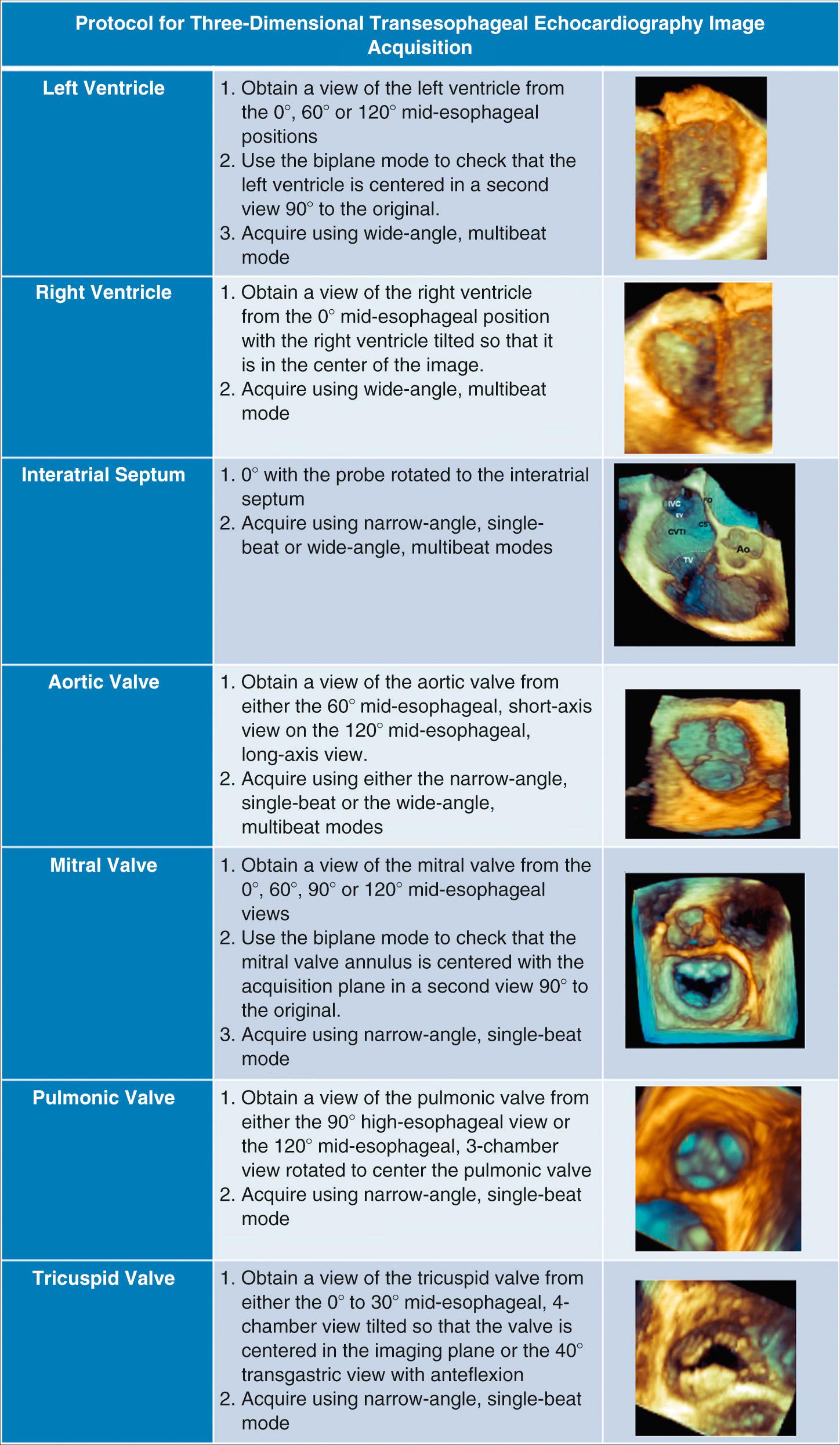
Quantitation of LV systolic function using the biplane apical approach with 2D imaging or 3D LV volumes is recommended when time allows ( Fig. 18.7 ). In addition, 3D volumetric imaging now is routine in views appropriate for the specific diagnosis and procedure, for example, 3D imaging of the interatrial septum in a patient undergoing atrial septal defect closure or 3D imaging of the mitral valve in patient with mitral regurgitation who is undergoing a transcatheter valve procedure.
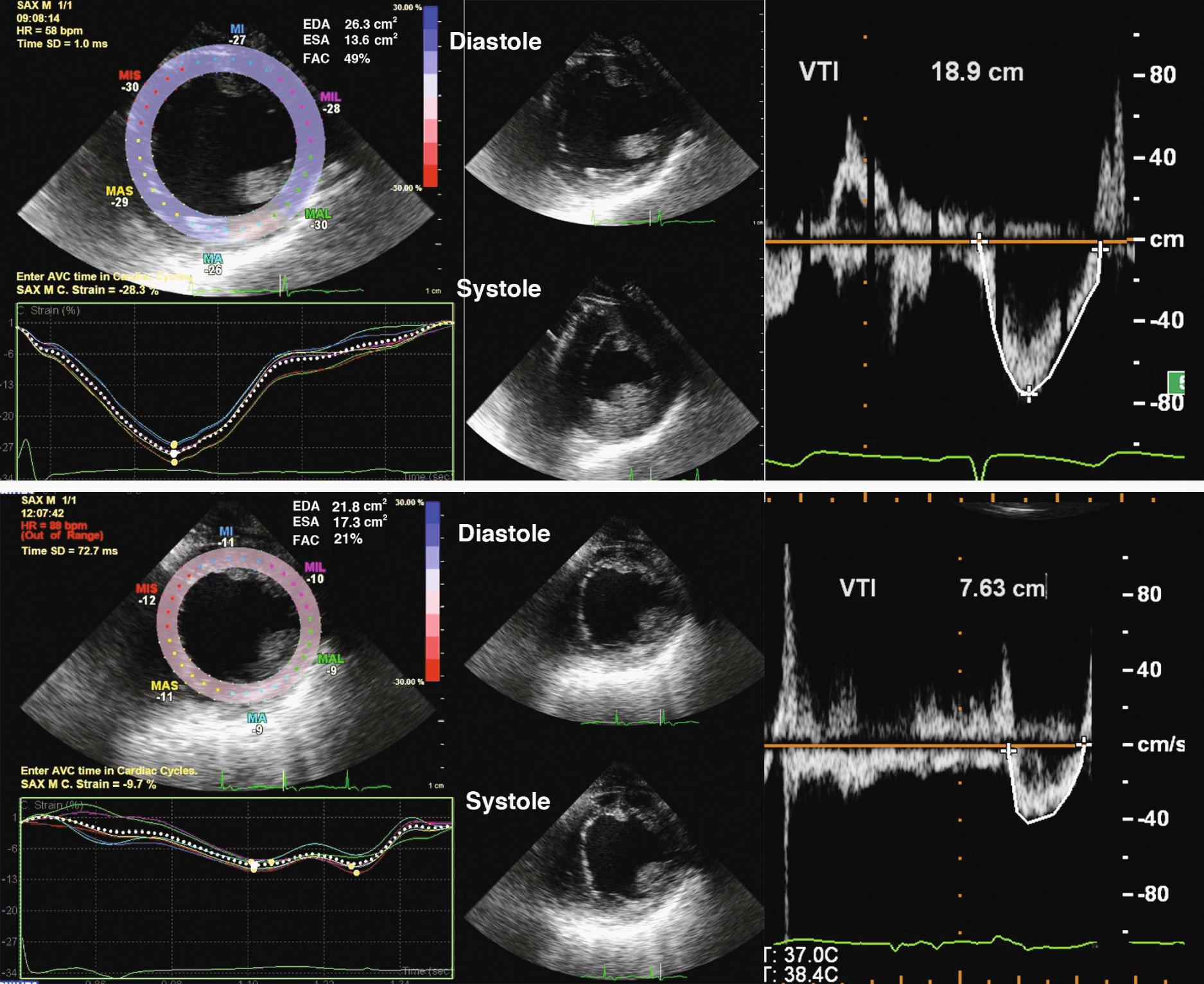
In addition to imaging data, a screening Doppler study is recommended. A basic intraprocedural TEE includes color Doppler evaluation for regurgitation of the aortic, mitral, and tricuspid valves in at least two orthogonal views. Evaluation of the pulmonic valve is more difficult and is needed only in specific situations, such as congenital pulmonic valve disease, after cardiac transplantation, or with right ventricular (RV) assist device placement. Additional Doppler data recordings are tailored to the specific clinical indication. For example, when significant regurgitation is present, additional color Doppler data, such as vena contracta, are recorded. Color Doppler also allows detection of intracardiac shunts, including a patent foramen ovale. Continuous-wave (CW) Doppler recordings are helpful for the evaluation of valve stenosis and regurgitation and for the estimation of pulmonary pressures, if a pulmonary artery catheter has not been placed. Pulsed Doppler recordings are used to evaluate LA filling via the pulmonary veins, LV diastolic filling, and atrial appendage function.
Several sequences of image acquisition are possible, and all are appropriate as long as the needed diagnostic images are obtained. Some echocardiographers prefer to obtain all the views from each transducer position:
Mid-esophageal
Transgastric
Upper esophageal
This approach minimizes the time needed for acquisition and is easy to remember.
In this sequence, starting in a mid-esophageal four-chamber view with depth adjusted to show the entire LV, the image plane is rotated toward the two-chamber view and then the long-axis view (see Fig. 3.3, Fig. 3.7, Fig. 3.9 ). The “mitral commissural” view describes a two-chamber plane in which both the medial and lateral commissures are seen, similar to the standard two-chamber view at about 60° rotation. An additional “two-chamber” view at about 90° rotation provides visualization of additional segments of the mitral valve and the LA appendage. These views also allow sequential evaluation of regional wall motion in the four-chamber view (inferior septum and lateral wall), the two-chamber view (inferior wall and anterior wall), and the long-axis view (posterior wall and anterior septum). A full-volume 3D acquisition allows measurement of LV ejection fraction, assessment of regional wall motion, and evaluation of global and regional longitudinal strain.
From the long-axis view, depth is decreased to focus on the aortic and mitral valves. Then the transducer is moved superiorly in the esophagus to visualize the ascending aorta, first in long axis (see Fig. 3.10 ), followed by rotation of the image plane to a short-axis view of the ascending aorta, with the pulmonary artery seen in long axis. The probe is advanced to a short-axis view of the aortic valve (see Fig. 3.13 ) and then the tricuspid and pulmonic valves. Turning the probe to the right with further rotation of the image plane yields the bicaval view of the right atrium (RA) (see Fig. 3.12 ). 3D real-time and multibeat volumetric images of the aortic and mitral valve are obtained from this probe position.
From the transgastric position, standard views include the short-axis views at the mid-LV and mitral valve levels, followed by rotation of the image plane to about 90° to show the two-chamber view (see Figs. 3.16 and 3.18 ). The probe is then turned rightward for a long-axis view, which includes the aorta, and an RV inflow view. From the deep transgastric position, an anteriorly angulated four-chamber view is obtained in some patients. The descending thoracic aorta is examined in sequential short-axis views from the level of the diaphragm to the arch, as the probe is slowly withdrawn in the esophagus. These short-axis views are supplemented with long-axis views at 90° rotation when abnormalities are seen. The arch is seen from an upper esophageal position by turning the image plane rightward, with a short-axis view obtained by rotation of the image plane.
Another approach is to evaluate each structure of interest in at least two orthogonal views, combining imaging, color, and spectral Doppler evaluations of each structure. With this approach, a complete examination includes:
All four cardiac chambers (LV, RV, LA, RA)
All four valves (aortic, mitral, tricuspid, pulmonic)
Both great arteries (aorta, pulmonary artery)
Systemic and pulmonary venous return (inferior vena cava, superior vena cava, four pulmonary veins)
Atrial septum and LA appendage
This approach is useful with a focused examination, starting with the primary structures of interest and continuing on to evaluate other structures as time allows. Even when a different sequence of imaging is used, the anatomic approach also provides a quick checklist to ensure that every structure has been evaluated before the examination is completed. 3D imaging is integrated into the 2D imaging sequence with the 3D examination focused on the specific structure of interest, such as the mitral valve in patients undergoing mitral valve repair.
Intraprocedural TEE results are communicated directly to the surgeon at the time of data acquisition to facilitate prompt decision making. Intraprocedural TEE results should be available throughout the surgical procedure, verbally or in written format. In addition, a permanent written or electronic report that includes indications, a description of the procedure, and diagnostic findings should be included in the medical record. The report should indicate whether a comprehensive examination (most of the 20 recommended views) was recorded or whether it was a focused or limited examination to address a specific clinical issue. Intraprocedural TEE images and reports should be stored at each medical center in digital format with other echocardiographic images and reports to allow later review and comparison with subsequent studies.
As with any echocardiographic study, intraprocedural 2D TEE images should be aligned in standard image planes corresponding to long-axis, short-axis, four-chamber, and two-chamber views, with scanning between standard image planes to ensure a comprehensive study. 3D views also are recorded in standard orientations (see Chapter 4 ). Internal anatomic landmarks are used to define correct image alignment. The rotation angles provided in tables serve only as a guide to the typical angle needed for a given view; the actual rotation angle varies from patient to patient. In addition, individual variability in the anatomic relationship between the esophagus and the heart results in variability in image plane orientation, so correct alignment of views is not always possible.
A parallel alignment between the Doppler beam and blood flow of interest is not always possible on TEE imaging. The probe position is constrained by the anatomic relationship between the esophagus and the heart, so even with careful adjustment of transducer position and rotation of the image plane, the interrogation angle is typically still nonparallel, with potential underestimation of flow velocities. Intercept angle has a limited impact on the diagnostic value of color Doppler because the color Doppler flow image corresponds to the spatial pattern of the flow disturbance, even though exact velocities cannot be accurately measured. For spectral Doppler recordings, a near-parallel alignment is easily obtained by TEE for antegrade and regurgitant flow across the mitral valve ( Fig. 18.8 ) and for LA appendage and pulmonary vein flow. From a high esophageal position, flow in the pulmonary artery also can be recorded at a near-parallel intercept angle. However, alignment of the Doppler beam with the LV outflow tract and transaortic flow is problematic. On mid-esophageal views, parallel alignment is not possible. Sometimes better alignment can be obtained from a transgastric long-axis view or a deep transgastric anteriorly angulated four-chamber view. However, underestimation of velocity is likely and should be considered, particularly with TEE evaluation of aortic stenosis severity.
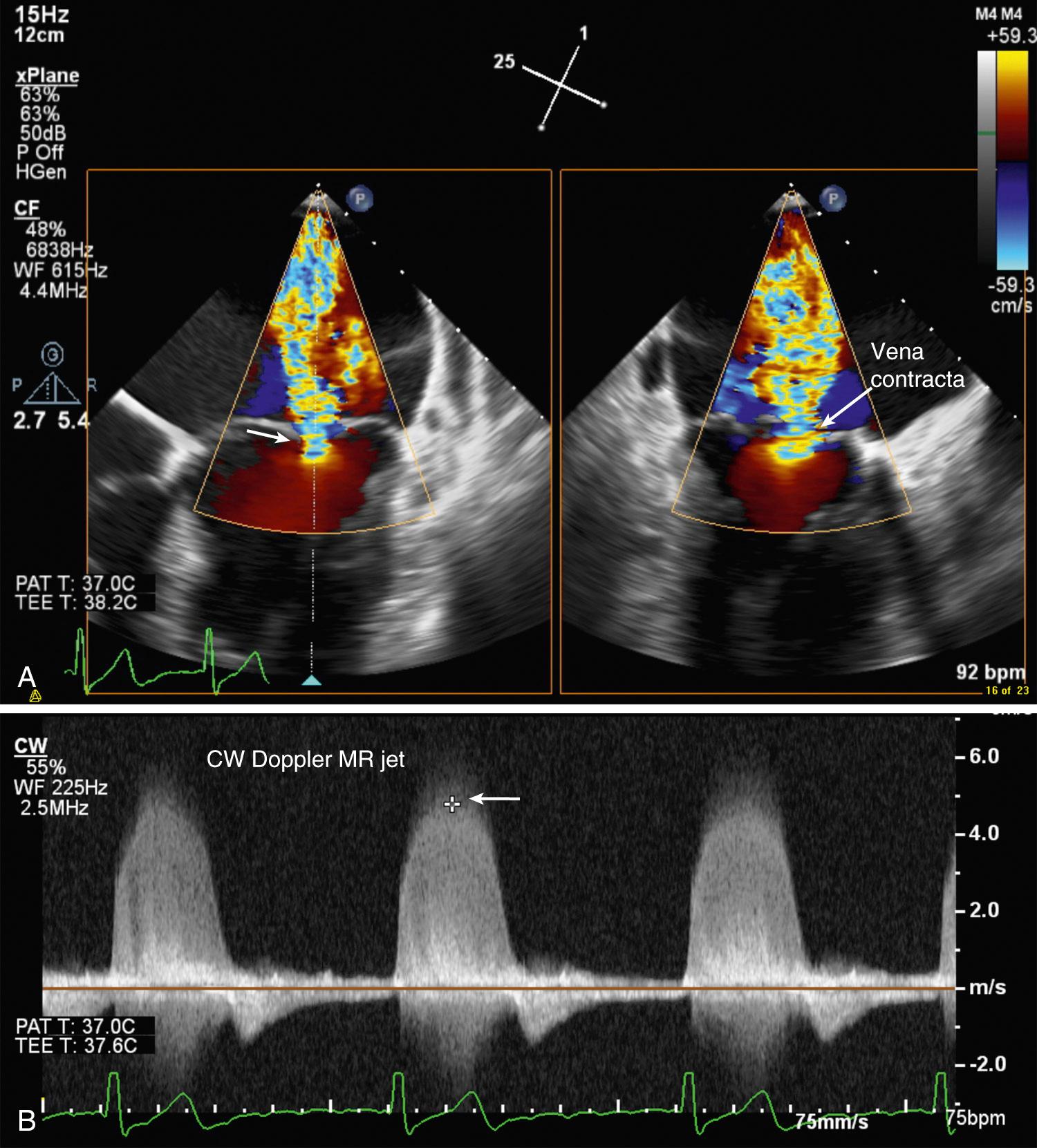
During intraoperative or intraprocedural TEE, the echocardiographer needs to be alert to interference or technical artifacts. Cannulas, catheters, and other devices cause acoustic shadows or reverberations, obscuring the structure or flow of interest ( Fig. 18.9 ). Electronic interference from electrocautery or other procedures precludes diagnostic images or Doppler data ( Fig. 18.10 ). If reverberations and shadowing cannot be avoided by repositioning the probe, alternate approaches, such as epicardial scanning with a sterile transducer, need to be considered. Electronic devices should be paused when possible to allow recording of echocardiographic data without interference artifacts.
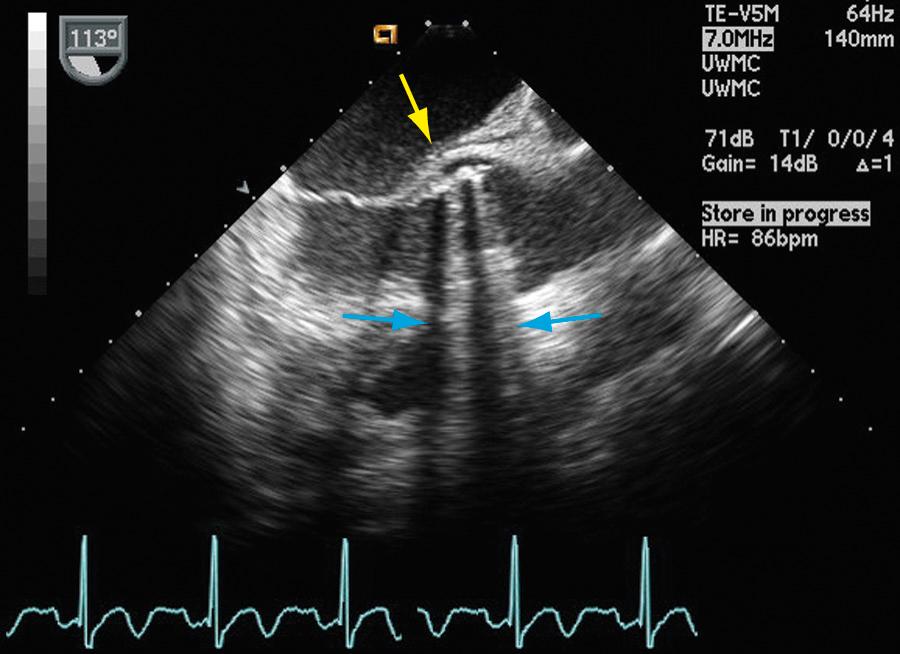
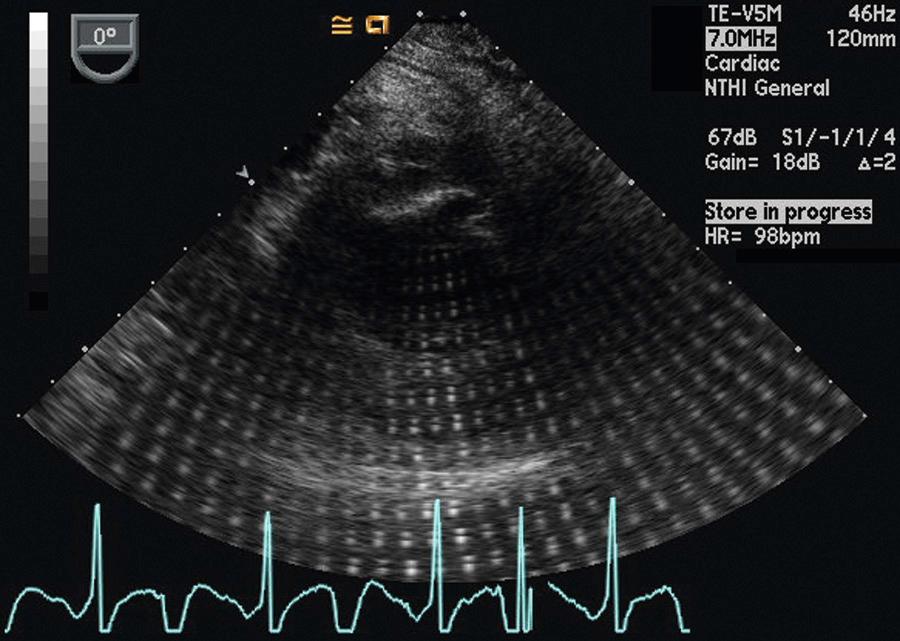
Become a Clinical Tree membership for Full access and enjoy Unlimited articles
If you are a member. Log in here